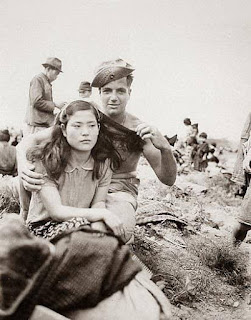Japanese historian Oshiro Masayasu writes about the large scale rape by American soldiers in Okinawa in 1945.
Japanese historian Oshiro Masayasu writes about the large scale rape by American soldiers in Okinawa in 1945. He reports the incident at a village in Motobu peninsula where GIs landed and found only women, children and old folks there. What followed was abominable. There was a hunt in broad daylight for Japanese women who were ravaged mercilessly.
According to Toshiyuki Tanaka, 76 cases of rape or rape-murder were reported during the first five years of the American occupation of Okinawa. However, this is probably not the true figure, as most cases went unreported.
Some women were also raped when they went to US camps to receive food hand-outs.
US troops landed on Zamami Island, a small island west of the main island, and began raping women there in March 1945, shortly after they had landed. They abducted the women, carried them one by one to deserted coastal areas and gang-raped them. After being raped, the women were allowed to go. There is also a testimony that some Okinawan nurses and local women patients who had been admitted to the US Field Hospital were raped by US soldiers. One of the victims, a young girl patient, was raped by a GI in front of her father who was in the tent attending to her. These victims had nowhere to report the crime even if they had wished to do so, the Japanese police system of Okinawa having completely collapsed during the battle.
American soldiers took young girls from civilian houses at gunpoint. These girls would later return with their clothes torn off. Some were even killed, although the perpetrators were never caught.
At about 11:00 am, only a few hours after the landing began and three hours before General MacArthur stepped out of his plane at Atsugi airport, two marines on an “inspection tour” entered a civilian house in Yokosuka, and raped a 36-year-old mother and her 17-year-old daughter at gunpoint. About 6:00 pm that day, two other marines entered another home in Asahi-chd and found a housemaid at home alone. While one of the marines was on watch at the door, the other made lewd gestures and tried to grab her. In fear she fled upstairs. The marines followed and raped her in turn in a small room upstairs.
1 Around 12:30 am on September 1, three American soldiers intruded in to the house of Mr. B. I., [the details of the address], Awa district in Chiba prefecture. These intruders showed something like a ten yen bank note to the housewife N., 28 years old and claimed intimacy to her by making gestures while upon receiving her flat refusal they brought her to the inner room and raped her in succession. 2 At about 2:00 pm the same day another four American soldiers intruded into the house of Mr. A. T., [the details of the address], the same village. They threatened the wife, T. aged 30 as well as his mother and then chased the three to the next room and one of the Americans violated T. in the first place. But at that time another three American soldiers entered the same house. They withdrew from the house without attaining their intended purposes satisfactorily. 3 At the same hour on that day seven American soldiers while ransacking the village office in Nishiki village, resorted to indecent acts such as touching breasts of the girl clerks or rubbing their cheeks. 4 Another several Americans resorted to the same acts to the girl clerks in the post office located in the same village
About 6 o’clock, in the afternoon of September 1st, two American soldiers in a truck forced two Japanese to guide them around the Yokohama city. When they came to Shojikiro, at Eirakucho, Naka-ku they forced Miss K. Y., aged 24, a maidservant, to board the truck against her will and absconded to the US Barracks in Nogeyama Park. There altogether 27 of the American soldiers violated her in turn and rendered her unconscious
There were also 1,336 reported rapes during the first 10 days of the occupation of Kanagawa prefecture after the Japanese surrender.
Schrijvers, Peter (2002). The GI War Against Japan - For instance, rape--which is considered a way to sharpen aggressiveness of soldiers, steeling male bonding among warriors, and, moreover, "reflects a burning need to establish total dominance of the other" (p. 211)--was a general practice against Japanese women. "The estimate of one Okinawan historian for the entire three-month period of the campaign exceeds 10,000. A figure that does not seem unlikely when one realizes that during the first 10 days of the occupation of Japan there were 1,336 reported cases of rape of Japanese women by American soldiers in Kanagawa






Comments
Post a Comment